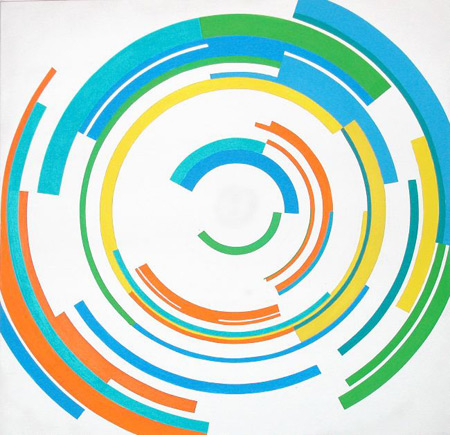
Continuing through March 2, 2013
This look “back to the sixties” reassesses the works of Hard-Edge painter and Southern California Abstractionist June Harwood. The decade was characterized by a sculptural manipulation of geometric forms - horizontal, vertical, diagonal shapes presented in angular and jagged iterations that feel like they are carved and coaxed from the perimeters of the canvas. Harwood’s subjects are dictated by a calculated tension in color story where combatant and complementary colors create a narrative that relates to the specificity of the forms that resist semblance to specific shapes found in the natural world, yet feel organic to the eye.
Harwood’s late husband, writer and eminent art critic Jules Langsner used “Hard-Edge” to describe a shared set of painterly characteristics found in the works of Lorser Feitelson, John McLaughlin, Karl Benjamin, and Frederick Hammersley. He coined the term in 1959 to describe a form of abstraction wherein the subjects are impeccably flat shapes characterized by clean and hard edges. While Langsner didn't refer to Harwood specifically as representative of the “Hard-Edge” style, her work embraced its tenants and even took it one step further by creating a flat surface devoid of any distraction. In 1964 Harwood was included in a group show curated by Langsner called “California Hard-Edge Painting” which catapulted her career and began a decade devoted to the style.
Her paintings of this period meditated on crafting meticulous shapes that possessed the intricacies of an elaborate geometric imagination. The exhibition begins with the preceding works of the “Silver Series” marked by repetitive lines that splintered in prisms of light and defied any physical relationship to one another. The “Colorforms” beginning in 1965 maintains continuity, however the shapes embrace the positive and negative space between each other and begin to interlock. It is with the “Colorforms Series” that Harwood pushed her forms to the edge of the canvas and uses its perimeters as a vessel to implicitly expand the forms into an infinite space, rather than confine them within the frame of the canvas. “Bulls Eye” exemplifies this boundless possibility with the expanding red, orange and blue bands of color to continue a visualization that is not seen but deeply felt. The intentional white space in the middle of the composition heightens the vibrancy of the colors that barely contain the bubble shape, like a thought bubble whose description has yet to be completed. The intentional focus on kinetics and optics appears in the various “Target” paintings where concentric and half circles of primary colors create the illusion that half of the target is moving while the center remains in place. The optical tug-of-war between the scalloped surface and the tension of the object combined with her keen understanding of color maintains that Harwood always targeted the bulls eye in executing her deceptively complex practice.
The “Loop Series” continued in the elongated oval forms found in “Rouge et Noir,” where the contrasting black and red shapes mirror each other and thus bolstered a bold color story which allowed the shapes to pop off the canvas. The explosive and gestural loops are turned on a slight angle and interconnected like links that are reminiscent of the gestures one makes to loosen the hand before drawing. Harwood still maintained a controlled composition anchored by flattened and smooth backgrounds.
A natural progression from the repetitive interconnected loops were the “Ribbons Series,” where a singular motif is composed of multiple twists and turns like a cursive letter. Presented in a nearly monochromatic color scheme, Harwood created the shapes by curling a ribbon and using an opaque projector to then trace on the canvas. While the background color was painted by hand, the primary form was created using a spray gun to maintain the flatness and a mechanical precision. The “Ribbons Series” begins to point to the influence of sculpture given how the image changes according the circumstances of light and the position of the viewer.
By the mid-sixties Harwood’s stamp on the “Hard-Edge” style was palpable in her exploration of controlled painterly environments that inspired animated shapes that explode off the surface. The “Network Series” explored the manipulation of space on black and grey surfaces and the ability for lines to bend so that they appear to be three-dimensional. The “Network Series” contends with the negotiation between the inherent flat surface of the canvas and the deliberate flatness of her arsenal of shapes. The repetitive arching lines almost surround the eye and play with the optics of the simple rectangular lines on the canvas. The sophistication demonstrated in the sixties speaks to Harwood’s ability to transform modest geometrical forms into sculptural objects.
Entering the 1970’s the emergence of the “Hexagon Series” marked the end of the artist’s experimentation with large, geometric forms. This coincided with her teaching tenure at Los Angeles Valley Arts College, where she remained until 1994. The repetitive honeycomb shape appears in various sizes to simulate the sense that one’s perception was bending around the canvas. The evolution of style comes full circle, as the decade began with disparate objects that fractured into space and ended with connected forms that shift in shade and perspective.
Published courtesy of ArtSceneCal ©2013
